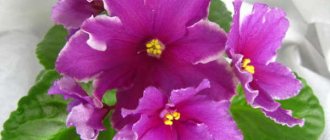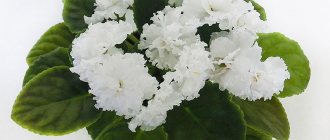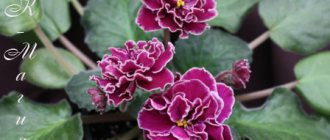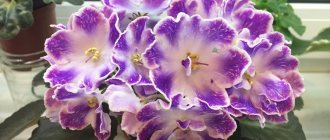One of the most favorite indoor plants can be called the violet. These unusually beautiful flowers are liked by gardeners because of their ease of care, long-lasting flowering, and the magic of colors. The collection of Tatyana Lvovna Dadoyan is especially popular. Experienced flower growers advise paying attention to the Water violet - a brightly colored variety with a cool ruffle. We bring to your attention a description of the variety, features of care and reproduction.
Violet Water: description
The Water violet variety has large double flowers of a bright blue rich color, with stripes or small areas of light pink along the edges of the petals, edged with a green fringe. The leaf is delicate, velvety, convex, green in color with a wavy edge. The bottom of the leaf is white, sometimes there may be red spots on it, the stems are light. The elegant fringe on large flowers distinguishes the Vodyanaya violet variety (Dadoyan has already developed several popular varieties). Saintpaulia really looks like underwater plants.
The children of this violet variety are curly, and the leaves can be light. Can be grown in a collection with other flowers that are similar in care and color scheme. For the Water violet, it is necessary to observe the thermal and light conditions, and do not forget about timely watering.
Reviews of violet Aquarius
Julia. Violet Aquarius is simply beautiful. The incomparable green ruffle against the background of blue petals is just a fairy tale. It’s as if you really find yourself at the bottom of the sea.
Margarita. This violet is my favorite. I bought it at an exhibition a few years ago as a piece of paper. When it bloomed for the first time, I thought I had been deceived. I even wanted to throw it away out of frustration. But on the third flowering, Aquarius gave me such beauty, and it was breathtaking. Now this is one of the best specimens in my collection.
We offer you to watch a video in which a florist shows the Vodyanaya violet variety.
Water violet blooming: photo
Violet bloom lasts about a month, a little longer in a cool room. For violets of this variety, the opening of the buds takes a long period of time. One peduncle usually has up to five buds in a bouquet. The diameter of the bud opens up to six centimeters. The Vodyanoy violet begins to bloom fully from the 3rd time, and the duration of flowering directly depends on the lighting.
Choosing soil and pot
Water violet should be replanted twice a year, it is better to do this in spring and autumn. There are few basic requirements for the soil - it is fairly loose, fertile soil with good moisture holding capacity. You can make this soil yourself, or you can purchase a ready-made soil mixture in the store.
It is necessary to choose the right size of the pot: its diameter should be slightly larger than the root system of the violet. In addition, it is better to choose a low and wide flowerpot. The material from which it is made should also be taken into account. If the pot is ceramic, then the moisture in it evaporates much faster than, for example, in a plastic one.
Reproduction and transplantation
Water violet reproduces by rooting leaves, peduncles or stepsons. Stepchildren form a rosette in abundance, from three to five pieces. During the annual transplantation of violets, they are separated from the mother rosette using an awl and planted in separate pots.
The plant can also be propagated by rooting a leaf or peduncle. A leaf for rooting is taken from an adult plant directly under the peduncle. Leaves from the center of the rosette and from the bottom row are not suitable for propagation.
Water violet is best propagated by separating flower stalks.
The leaf is carefully broken off, and then a cut is made at an angle of 45 degrees and placed in a glass of water or a mixture of sand and soil. The cuttings are buried no more than 1 centimeter. During spring rooting, babies appear on the cuttings after 2 months.
The peduncle for rooting is cut off along with the stipules and placed in a glass of water. Peduncles with flowers that have blossomed or have begun to fade are suitable for rooting. The procedure is carried out with a sharp, disinfected knife. The cut area is sprinkled with crushed charcoal.
Transfer rules
Indoor violets are replanted annually, in the spring, since during the growing season the soil in the pot is depleted and there is not enough fertilizer to nourish the plant. The soil for the plant must be selected as loose and light as possible. You can use ready-made soil for violets from the store or make a mixture yourself from leaf and turf soil, peat, sand and vermiculite.
The pot for replanting is taken 1-2 centimeters larger than the root system of the plant. The pot should gradually increase in size as the violet grows and matures. As soon as the size of the pot reaches 10 centimeters in diameter, its increase is stopped. You cannot plant violets in pots that are too large. Until the roots fill all the spaces of the dishes, the violet will not bloom.
Care
Growing beautiful, lush violets at home is quite simple, the main thing is to strictly follow the recommendations for caring for these plants. And then it will respond with lush and long flowering.
In order to get abundant flowering of violets, you need to provide the plants with proper care. If Saintpaulias do not begin to bloom, the following reasons are possible:
- plants do not have enough lighting;
- short daylight hours;
- lack of microelements;
- dry air.
All this can be easily corrected: use artificial lighting, feed the plants, and carry out regular spraying.
Lighting
Violets (Saintpaulias) require a large amount of light, preferably diffused. Direct sunlight is extremely undesirable for them, as it can cause leaf burn in plants. If the violet is on the windowsill on the south side, the plants need to be shaded. And in order for the violet to bloom all year round, artificial lighting is also suitable: it should be approximately 12 hours a day.
How to grow?
The main requirement when growing violets, including “Water” violets, is careful selection of a place for planting. The lighting should be quite intense, but avoid contact with direct sunlight. The best place in the premises is the eastern windows. There the morning rays will fall on the flower, which will provide the necessary energy and will not harm the plant.
If this is not possible, placing violets on western, northwestern and northeastern windows is allowed. But this does not mean that “Vodyany” cannot be grown in houses where there are only southern windows. You just have to shade the plants with blinds and blackout curtains.
But you can’t put them on northern windows - this will end in inevitable failure.
Every gardener who has ever tried to grow violets on a north window has encountered serious problems. Either it develops slowly, or it blooms weakly and reluctantly. But when there is no other choice, you have to compensate for the lack of sunlight with the help of artificial lamps. They should increase the duration of the daylight period to 10, and ideally to 12 hours. Along with special phytolamps for illumination, you can use household fluorescent lamps.
In order for the violet to grow normally, the air temperature will have to be maintained at no lower than 20 and no higher than 24 degrees Celsius. If the temperature goes beyond this corridor, it will inevitably damage the plants. You should also remember about the required humidity level. It ranges from 50 to 60%.
The maximum value is maintained by choosing the right location, and water tanks help avoid drying out.
Temperature and humidity
For Saintpaulias, the most ideal temperature is considered to be from 20 to 24 degrees Celsius. For young plants, the room in which they are located can be made a little warmer. There should be no difference between day and night temperatures.
Water violet is especially demanding of humidity due to the fact that in its natural environment it lives in a fairly humid climate. To create comfortable conditions for the violet, it is necessary to maintain a high level of humidity in the room or periodically spray the air around the plants.
Water violet: cultivation and care
Violet Water: photo
Water violet should only be grown in a sufficiently lit room. However, flowers should be protected from direct sunlight. You also need to be very careful when choosing a place to grow this variety. It is better if it is on the eastern side of the apartment, this is where the morning rays of the sun will hit the plant and will not have a negative impact in the form of a burn. However, if this option is not available, then it is permissible to grow violets on the western side, as well as on northern windows.
Light
Here you need to control the lighting yourself and create additional lighting artificially in dark places. And in too bright rooms you can create a shadow using curtains. If the window faces the northern side of the world, then it is unlikely that you will be able to grow a violet here, since it will grow and develop very slowly, and the flowering will be completely different. However, you can fix everything by creating artificial lighting using special phytolamps. Thus, the violet should be illuminated for 12 hours a day. In addition, you can use ordinary fluorescent lamps.
Temperature and humidity
The optimal temperature for growing the plant will be between 20 and 24 degrees. At the same time, both exceeding this indicator and a lower temperature will have a negative impact on the plant.
You should also create an optimal humidity level, which will be no less than 50 and no more than 60%. When the air is too dry, you can install a humidifier or containers filled with water.
Watering
Dadoyan's Water Violet needs to be watered correctly. At the same time, it is necessary to control that there is no moisture deficiency, as well as waterlogging. The watering regime will be approximately two or three times a week, depending on the temperature of the room where the flower grows. The water must be warm and allowed to sit for 24 hours.
If you use cold water for watering, the plant may become sick and the roots will begin to rot. It is best to use special watering cans or a syringe to prevent moisture from getting on the leaves, and especially on the center of the plant, which will inevitably lead to rot. If water suddenly gets on the leaves, they need to be wiped with a cloth.
Also, to avoid improper watering, you can water the plant by filling the tray, and then placing the pot in it. In this case, after about half an hour, the excess moisture is poured out. This is enough for the roots to absorb all the moisture they need. This will prevent you from overwatering the plant.
Experienced gardeners use wick irrigation. When planting, lay some kind of cord initially and then place its top in a glass of water. The cord gets wet and evenly nourishes the ground.
The Dadoyan Water Violet is characterized by a fleecy covering of the leaf plate, so a lot of dust accumulates on it. From time to time it is necessary to give the plant a shower. To do this, it should be better to place it in the bathroom and pour warm water over it. Until the plant dries, it is prohibited to place it on the windowsill, as this can cause sunburn.
Feeding
In addition, the Vodyanoy violet variety should be regularly fertilized with the elements necessary for growth and development. These include nitrogen, phosphorus and potassium.
You should be careful about the dosage of each drug, since incorrect use will have a negative effect on the plant. It is also better to use ready-made complex fertilizer: superphosphate, humus or humus. It is necessary to fertilize plants with organic matter at the moment of rosette formation. When the plant begins to form flowers, it is better to use phosphorus-containing preparations and potassium-containing fertilizers. The optimal fertilizer regime will be once every 2 weeks, directly under the root of the plant.
And if it happened that you had to replant the Water violet, then it is not recommended to fertilize it for a month. In addition, do not feed sick plants, as well as plants during treatment for pests. If the room is too hot, then it is better to stop feeding too. In addition, the plant does not need fertilizer during the cold months of the year, since it is in a dormant stage and does not need to be stimulated to grow.
In addition, experienced gardeners do not recommend feeding Vodyanaya violets using tablets or dry granules, since violets are usually grown in a small container, and here the probability of incorrect dosage is very high.
Trimming
As noted above, the Vodyanoy violet can evenly form a rosette. However, if you periodically turn the pot every three days, the bush will look more decorative. Peduncles that have already finished flowering must also be cut off, as well as old dry leaves removed. Thus, every 5 years the rosette is shortened a little. And when roots appear, you should transplant the rosette into a pot.
Protection from diseases and pests
Like all plants, violets suffer from diseases and pests. The most common pests include mealybugs and spider mites. In order to get rid of a tick, you need to use insectoacaricidal drugs. For example, such as "Aktellik" or "Fitoverm". When fighting mealyworms, you can use any of the insecticidal preparations. But still, at home it is better to use the Aktara product; the drug is quite effective, fast-acting, and odorless. Usually a single treatment is sufficient.
Most of all, violets are susceptible to rot of various origins. To avoid this, you should be careful about watering and avoid excessive waterlogging of the soil.
Disease prevention and pest control
Violation of the rules for caring for violets can cause fungal diseases:
- fusarium;
- powdery mildew;
- gray rot;
- late blight;
- vascular bacteriosis;
- rust.
The main reason why plants are affected by fungus is waterlogging of the soil combined with cold. Brown or brown spots, white or gray coating appear on the violet. At the first signs of disease, the plant should be transplanted into new soil, changing the pot and sprayed with an appropriate fungicide.
Water violet is susceptible to gray rot, fusarium and other fungal diseases.
Violet is often attacked by insect pests.
When infected, the following signs appear on the leaves:
- Ash plaque – cyclamen mite. When infected with a mite, violet leaves begin to curl and the plant looks depressed. To prevent infection with the cyclamen mite, violets are sprayed with an insecticide every six months.
- Mealybug - settles in the axils of the leaves, then penetrates the root system. The plant must be treated with Aktara, Alatar, Fitoverm three times at intervals of a week.
- Sticky coating on the surface of the leaves and brownish spots on the underside are aphids. The violet should be washed with soapy water and then sprayed with insecticide.











